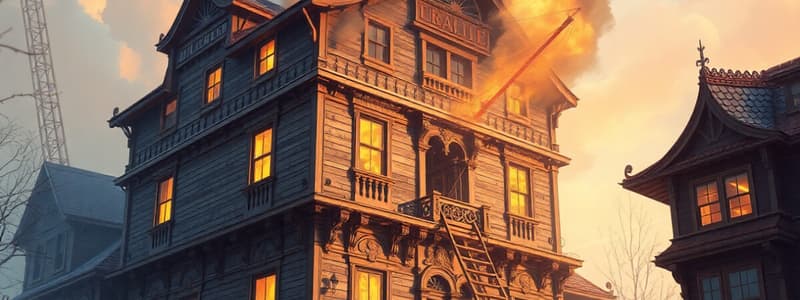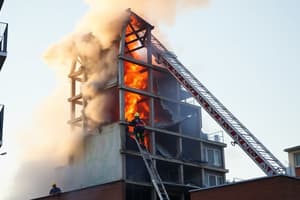Podcast
Questions and Answers
What might be a consequence of renovations being done without a permit?
What might be a consequence of renovations being done without a permit?
- Higher likelihood of structural weaknesses (correct)
- Increased safety inspections
- Guarantee of compliance with building codes
- Improved structural integrity of the building
Why is a 40 yards dumpster parked in front of a building considered a significant danger sign for firefighters?
Why is a 40 yards dumpster parked in front of a building considered a significant danger sign for firefighters?
- It is a sign of prior fire damage.
- It indicates no one is actively using the building.
- It may hide structural issues from firefighters.
- It suggests ongoing renovations that could compromise safety. (correct)
What action should firefighters take if renovations are occurring without a permit?
What action should firefighters take if renovations are occurring without a permit?
- Ignore the renovations as they will not affect safety.
- Proceed with extinguishing any fires without concern.
- Contact the code enforcement authorities. (correct)
- Evacuate the building immediately.
Which of the following is NOT a common cause of structural collapse on the fireground?
Which of the following is NOT a common cause of structural collapse on the fireground?
What crucial acknowledgment must incident commanders and firefighters make regarding structural collapse?
What crucial acknowledgment must incident commanders and firefighters make regarding structural collapse?
What is the expected burn-through rate of wooden structural elements during open-burning time?
What is the expected burn-through rate of wooden structural elements during open-burning time?
What is a major danger presented by unprotected steel pipe columns during a fire?
What is a major danger presented by unprotected steel pipe columns during a fire?
How long might lightweight steel-bar joists retain their strength in a fire?
How long might lightweight steel-bar joists retain their strength in a fire?
At what temperature should unprotected steel lally columns be expected to fail?
At what temperature should unprotected steel lally columns be expected to fail?
What can provide warning to firefighters working on a steel deck before total failure?
What can provide warning to firefighters working on a steel deck before total failure?
What happens if fire attacks two sides of a standard 1 1/2-in.-wide (2x8) wooden joist?
What happens if fire attacks two sides of a standard 1 1/2-in.-wide (2x8) wooden joist?
What happens when there is as little as 1 psi exerted laterally on a brick wall during an explosion?
What happens when there is as little as 1 psi exerted laterally on a brick wall during an explosion?
Which tactic is recommended when flammable gases or explosives are present?
Which tactic is recommended when flammable gases or explosives are present?
Which chapter suggests taking precautions against destructive events like backdraft?
Which chapter suggests taking precautions against destructive events like backdraft?
What is a primary characteristic of cast iron that affects its suitability for certain structural applications?
What is a primary characteristic of cast iron that affects its suitability for certain structural applications?
Which of the following factors does NOT contribute to the potential failure of highly heated cast-iron columns?
Which of the following factors does NOT contribute to the potential failure of highly heated cast-iron columns?
What consequence can occur when cast iron is subjected to sudden cooling after being highly heated?
What consequence can occur when cast iron is subjected to sudden cooling after being highly heated?
According to Professor Francis Brannigan, what is a significant risk factor for cast-iron columns leading to structural failure?
According to Professor Francis Brannigan, what is a significant risk factor for cast-iron columns leading to structural failure?
What is the primary risk associated with bales of materials absorbing water?
What is the primary risk associated with bales of materials absorbing water?
What weight is cited as a typical concern for bales of absorbent materials when dry?
What weight is cited as a typical concern for bales of absorbent materials when dry?
What type of materials are most likely to contribute to the risk of floor overload when absorbing water?
What type of materials are most likely to contribute to the risk of floor overload when absorbing water?
What is the weight added to a building by a 1,000-gpm master stream in one minute?
What is the weight added to a building by a 1,000-gpm master stream in one minute?
Which condition significantly contributes to structural overload during firefighting operations?
Which condition significantly contributes to structural overload during firefighting operations?
How much weight does an accumulation of water 1 ft deep over an area of 20 ft by 20 ft add to a building?
How much weight does an accumulation of water 1 ft deep over an area of 20 ft by 20 ft add to a building?
Which of the following structures is mentioned as having a heavy load without fire present?
Which of the following structures is mentioned as having a heavy load without fire present?
What is the safest method of cutting flooring when structural weakness is suspected? And you don’t want vibrations
What is the safest method of cutting flooring when structural weakness is suspected? And you don’t want vibrations
Which external factor can lead to structural collapse independent of building age?
Which external factor can lead to structural collapse independent of building age?
What should be continually examined to predict potential collapses?
What should be continually examined to predict potential collapses?
What common misconception may lead to an underestimation of a building's collapse risk?
What common misconception may lead to an underestimation of a building's collapse risk?
Which method should be employed to minimize vibrations when working near a potentially collapsing structure?
Which method should be employed to minimize vibrations when working near a potentially collapsing structure?
Why should firefighters be cautious about cutting structural members during an overhaul?
Why should firefighters be cautious about cutting structural members during an overhaul?
What is the effect of impact loads compared to gradual application of weight on a damaged structure?
What is the effect of impact loads compared to gradual application of weight on a damaged structure?
Which behavior should firefighters actively avoid to maintain stability in damaged areas?
Which behavior should firefighters actively avoid to maintain stability in damaged areas?
When is it acceptable to remove structural components during an overhaul?
When is it acceptable to remove structural components during an overhaul?
What should firefighters prioritize when operating in areas that are marginally stable?
What should firefighters prioritize when operating in areas that are marginally stable?
Flashcards
Structural Weakness Causes
Structural Weakness Causes
Poor design, inadequate construction, or illegal renovations can cause structures to weaken.
Renovation Safety
Renovation Safety
Renovations need professional evaluation to ensure structural safety and integrity.
Dumpster & Renovations
Dumpster & Renovations
A dumpster at a fire scene indicates ongoing renovations, potentially compromising structural integrity.
Firefighter Investigation
Firefighter Investigation
Signup and view all the flashcards
Unauthorized Renovations
Unauthorized Renovations
Signup and view all the flashcards
Wooden Bowstring Trusses
Wooden Bowstring Trusses
Signup and view all the flashcards
Wooden Element Burning Rate
Wooden Element Burning Rate
Signup and view all the flashcards
Two-Sided Wooden Joists
Two-Sided Wooden Joists
Signup and view all the flashcards
Lightweight Steel Joist Fire Risk
Lightweight Steel Joist Fire Risk
Signup and view all the flashcards
Steel Sagging
Steel Sagging
Signup and view all the flashcards
Unprotected Steel Columns
Unprotected Steel Columns
Signup and view all the flashcards
Cast Iron Shattering
Cast Iron Shattering
Signup and view all the flashcards
Cast Iron Vulnerability
Cast Iron Vulnerability
Signup and view all the flashcards
Cast Iron Failure Temperature
Cast Iron Failure Temperature
Signup and view all the flashcards
Low-Order Explosions
Low-Order Explosions
Signup and view all the flashcards
Firefighter Tactics
Firefighter Tactics
Signup and view all the flashcards
Absorbent Material Overloading
Absorbent Material Overloading
Signup and view all the flashcards
Structural Overloading
Structural Overloading
Signup and view all the flashcards
Structural Member Removal
Structural Member Removal
Signup and view all the flashcards
Impact Load Prevention
Impact Load Prevention
Signup and view all the flashcards
Elevating Platform Risk
Elevating Platform Risk
Signup and view all the flashcards
Collapse Indicators
Collapse Indicators
Signup and view all the flashcards
Natural Element Hazards
Natural Element Hazards
Signup and view all the flashcards
Aging Building Collapse Risk
Aging Building Collapse Risk
Signup and view all the flashcards
Stability Assessment
Stability Assessment
Signup and view all the flashcards
Study Notes
Common Causes of Structural Collapse
- Structural weakness may arise from poor design, inadequate construction, or illegal renovations.
- Major past incidents, like the Vendome Hotel disaster, highlight the risks linked to unauthorized structural changes.
- Renovations should be evaluated by professionals to ensure safety and integrity.
Danger Signs for Firefighters
- The presence of a dumpster indicates ongoing renovations that may compromise structural integrity.
- Investigate what renovations are taking place and their potential effects during a fire.
- Engage code enforcement when work lacks a permit, ensuring that designs are reviewed for weaknesses.
Fire Damage to Wooden Structures
- Wooden bowstring trusses have been linked to several firefighter fatalities historically.
- Wooden elements can burn through at a rate of 1 inch every 45 minutes of exposure, influencing load-bearing capacity.
- If exposed on two sides, standard wooden joists can fail much earlier than expected.
Heating of Unprotected Steel
- Lightweight steel joists lose structural strength in 5-10 minutes under fire conditions.
- Steel begins to sag before failure, which may provide a warning to firefighters but may not be noticeable to those below.
- Unprotected steel columns can rupture intensely when heated, leading to sudden and catastrophic failures in supported structures.
Cast-Iron Column and Facade Risks
- Cast iron is often prone to shattering when exposed to high temperatures followed by rapid cooling.
- Irregularities in casting may contribute to increased vulnerability to temperature fluctuations.
- Critical structural failures can occur when cast-iron columns exceed about 800°F.
Explosions and Pressure Changes
- Low-order explosions can dramatically increase internal pressure, posing collapse risks.
- Firefighters should adopt defensive tactics if flammable substances are present and prepare for potential backdrafts.
Overloading Risks from Absorbent Materials
- Manufacturing materials like newsprint and cotton can absorb water, significantly increasing weight and risk of collapse.
- Heavy absorbent bales can swell, compromising structural integrity and supporting columns.
General Overloading of Floors and Roofs
- Accumulated weight from snow, equipment, or runoff from firefighting can lead to structural failure.
- A large volume of water can add considerable weight, stressing floors beyond their load capacity.
Risks from Cutting or Removing Structural Members
- Firefighters must avoid haphazard removal of structural components during overhaul unless deemed non-load-bearing.
- Careful assessment is critical to prevent unintended collapses.
Impact Load and Structural Stability
- Firefighters should refrain from causing unnecessary vibrations or impact loads that could destabilize structures.
- Gentle movements are safer than abrupt impacts in potentially compromised areas.
Collapse Indicators
- Using elevating platforms too close to buildings can inadvertently cause structural damage.
- Minimize vibrations and impacts during operations around suspected weak structures.
Miscellaneous Causes of Collapse
- Natural elements like high winds or flooding can contribute to structural failures.
- Aging buildings, typically over 100 years old, may be more susceptible to collapse due to accumulated stress.
Preventative Measures for Firefighters
- Continuous assessment of building stability and fire conditions is crucial for avoiding collapse dangers.
- Maintain vigilance as structural integrity can degrade rapidly under extreme conditions.
Studying That Suits You
Use AI to generate personalized quizzes and flashcards to suit your learning preferences.




